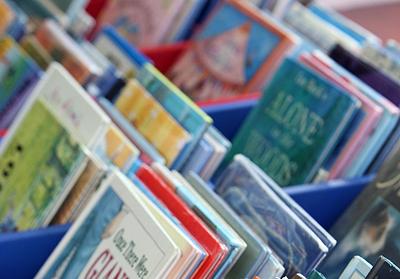Looking for all Articles by Alan Dapré ?
Alan Dapré explores the power of picture books
Award-winning children’s book author Alan Dapré shares his insights into the magic of picture books – and why comparing them to high-end adult literature does no one any favours.

My last book was a picture book. The next one will be too. I’m drawn to the simplicity of the text, and the complexity of the challenge. How to tell a captivating, engaging and entertaining story in a few hundred words.
Recently, I’ve read comments on social media that praise high-end literature at the expense of cheaper literature. Suggesting a sliding scale, with books for children at the lower end – and unsophisticated picture books at the bottom.
It’s like comparing apples to oranges. Books, like fruit, come in all shapes and sizes. Appealing to different tastes.
All books offer a journey of discovery
I suppose, for adults, high-end literature refers to intellectual works that possess artistic merit and require critical thinking and introspection. Such works contain complicated plots, cultural references, innovative use of vocabulary and conceptual challenges. They seek to surprise, delight and even educate the reader.
Picture books set readers on a similar journey of discovery. Albeit in a more pared down way. Just because a book uses bigger words and fewer pictures, it doesn’t mean it’s a better book. Or that it should be ranked more highly. All books have value. Reading is subjective, and one person’s unputdownable page-turner is another person’s doorstop.
Picture books can offer big themes in small packages
Picture books help children make sense of the world around them. Young readers literally control the narrative as they turn pages and interact with content. Reading is a full-on, immersive experience. Looking for hooks and context, investigating meaning and working out the point of a story. Children happily discovering hidden or unstated meanings within illustrations.
The slimmest of texts can contain big issues and heavy topics. Sadness, loss, identity, happiness, etc. All encapsulated in a colourful, illustrated short story. Picture books give young minds a handle on amorphous concepts; what it is to care, to share, to love.
How picture books offer space for self-expression
Children need to express themselves in a tactile and sensory way. By letting off steam, exploring, investigating and testing. Picture books have their place in this. There’s a joy in yelling sounds, memorising and repeating rhymes, sharing favourite words and phrases. My daughter, age two, knew every word of The Gruffalo (other picture books are available) and ‘read’ it expressively, sometimes closing the book and verbally sharing the story with me.
A picture book stimulates the imagination, and encourage readers to question, speculate and wonder. This is powerful stuff. Truly high-end learning for these young children, as they take their early steps towards literacy.
Award-winning literary books contain complex ideas and vocabulary. They engage my adult brain’s capacity to reflect, reason and reappraise. But I wouldn’t be able to do that without having come into contact with picture books from an early age. Picture books helped shape the person I am now.
The big impact of books that resonate
At age six, I was placed in a big, busy children’s home. The noise and rules took a lot of getting used to. I retreated into myself, and took comfort in books. I vividly remember reading about an unloved caterpillar, teased by all who met it. By the end of the story, it was a beautiful butterfly, soaring skyward, with glorious wings and a joyful smile. I wanted to be that butterfly, flying free!
Picture books resonate and captivate. They demonstrate their importance every day, lifting young readers higher. Taking them - and many adults alongside - to new and wonderful places.
So, regardless of where we end up, let’s value what we read all those years ago. Let’s acknowledge where we come from.
Picture books may be lowly caterpillars to some people.
But they’re high-flying butterflies to me!
Looking for a little inspiration for your next project? Check out Alan’s article, Five things to remember when writing for children.